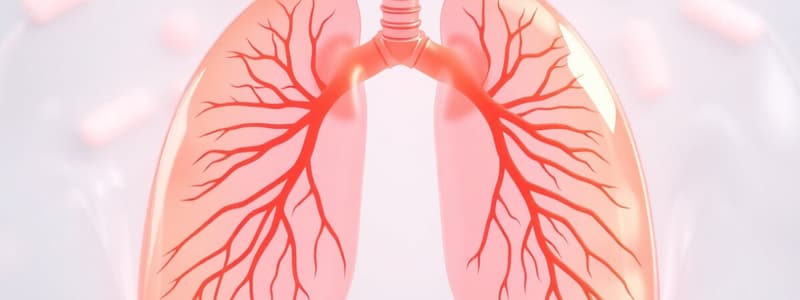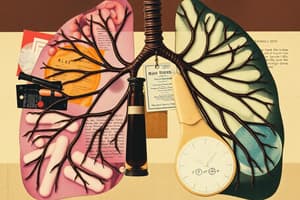Podcast
Questions and Answers
Which field specifically studies the genetic factors that influence how a person responds to a drug?
Which field specifically studies the genetic factors that influence how a person responds to a drug?
- Toxicology
- Pharmacognosy
- Therapeutics
- Pharmacogenetics (correct)
A respiratory therapist is asked to administer a medication to a patient. According to drug naming conventions, what type of drug name is the respiratory therapist most likely seeing on the label?
A respiratory therapist is asked to administer a medication to a patient. According to drug naming conventions, what type of drug name is the respiratory therapist most likely seeing on the label?
- Chemical name
- Code name
- Generic name (correct)
- Official name
During the drug approval process, a pharmaceutical company has completed animal studies and is ready to begin clinical trials with human subjects. Which of the following steps must the company take next?
During the drug approval process, a pharmaceutical company has completed animal studies and is ready to begin clinical trials with human subjects. Which of the following steps must the company take next?
- Request Investigational New Drug (IND) approval. (correct)
- Begin Phase III clinical trials.
- Classify the drug according to the FDA's system.
- Submit a New Drug Application (NDA) to the FDA.
A physician prescribes a medication with the following directions: 'Take 2 tablets PO BID prn for pain.' Which part of the prescription provides these instructions to the patient?
A physician prescribes a medication with the following directions: 'Take 2 tablets PO BID prn for pain.' Which part of the prescription provides these instructions to the patient?
A certain drug is derived from a plant source and is used to treat a respiratory condition. Which of the following drugs fits this description?
A certain drug is derived from a plant source and is used to treat a respiratory condition. Which of the following drugs fits this description?
A patient presents with upper airway swelling. Which type of adrenergic agent would be most appropriate to administer?
A patient presents with upper airway swelling. Which type of adrenergic agent would be most appropriate to administer?
Ipratropium bromide is prescribed for a patient with COPD. What is the primary mechanism of action for this medication?
Ipratropium bromide is prescribed for a patient with COPD. What is the primary mechanism of action for this medication?
Which of the following best describes the intended action of mucoactive agents in respiratory therapy?
Which of the following best describes the intended action of mucoactive agents in respiratory therapy?
A child with asthma is prescribed montelukast. What is the primary goal of this medication in managing the child's condition?
A child with asthma is prescribed montelukast. What is the primary goal of this medication in managing the child's condition?
A patient with a confirmed Pneumocystis jiroveci pneumonia (PCP) infection is prescribed an anti-infective agent. Which medication is most likely to be administered?
A patient with a confirmed Pneumocystis jiroveci pneumonia (PCP) infection is prescribed an anti-infective agent. Which medication is most likely to be administered?
What is the primary indication for administering exogenous surfactants to newborns?
What is the primary indication for administering exogenous surfactants to newborns?
Which of the following is a clinical indication for prescribing prostacyclin analogs?
Which of the following is a clinical indication for prescribing prostacyclin analogs?
A cystic fibrosis patient has a chronic pseudomonas aeruginosa infection. Which anti-infective agent is the MOST appropriate treatment?
A cystic fibrosis patient has a chronic pseudomonas aeruginosa infection. Which anti-infective agent is the MOST appropriate treatment?
A physician prescribes a medication with the following instructions: 'Administer 2 puffs qid prn for wheezing.' What does this order indicate to the patient?
A physician prescribes a medication with the following instructions: 'Administer 2 puffs qid prn for wheezing.' What does this order indicate to the patient?
A patient with asthma is prescribed albuterol. What is the primary expected outcome of this medication?
A patient with asthma is prescribed albuterol. What is the primary expected outcome of this medication?
What is the key distinction between a brand-name drug and its generic substitute?
What is the key distinction between a brand-name drug and its generic substitute?
A patient is prescribed a medication to be administered 'qod'. How should the patient interpret this instruction?
A patient is prescribed a medication to be administered 'qod'. How should the patient interpret this instruction?
Compared to systemic administration, what is a key advantage of delivering a respiratory medication via aerosolization?
Compared to systemic administration, what is a key advantage of delivering a respiratory medication via aerosolization?
Which of the following is NOT one of the drug groups related to respiratory care?
Which of the following is NOT one of the drug groups related to respiratory care?
Which route of drug administration is indicated by 'IV'?
Which route of drug administration is indicated by 'IV'?
A patient's prescription reads: 'ipratropium 500 mcg q4h'. How many times a day should the patient administer this medication?
A patient's prescription reads: 'ipratropium 500 mcg q4h'. How many times a day should the patient administer this medication?
Flashcards
Drugs
Drugs
Any chemical that alters the organism's functions or processes.
Pharmacology
Pharmacology
The study of drugs, including their origins, properties, and interactions with living organisms.
Respiratory Care Pharmacology
Respiratory Care Pharmacology
The application of pharmacology to cardiopulmonary disease and critical care.
Therapeutics
Therapeutics
Signup and view all the flashcards
Prescription Parts
Prescription Parts
Signup and view all the flashcards
α-Adrenergic Agents
α-Adrenergic Agents
Signup and view all the flashcards
Anticholinergic Bronchodilators
Anticholinergic Bronchodilators
Signup and view all the flashcards
Mucoactive Agents
Mucoactive Agents
Signup and view all the flashcards
Antiasthmatic Agents
Antiasthmatic Agents
Signup and view all the flashcards
Anti-infective Agents
Anti-infective Agents
Signup and view all the flashcards
Exogenous Surfactants
Exogenous Surfactants
Signup and view all the flashcards
Prostacyclin Analogs
Prostacyclin Analogs
Signup and view all the flashcards
Pentamidine
Pentamidine
Signup and view all the flashcards
Over-the-counter (OTC) drugs
Over-the-counter (OTC) drugs
Signup and view all the flashcards
Generic substitution
Generic substitution
Signup and view all the flashcards
q
q
Signup and view all the flashcards
po
po
Signup and view all the flashcards
Advantages of inhaled aerosol drugs
Advantages of inhaled aerosol drugs
Signup and view all the flashcards
β-Adrenergic effect on lungs
β-Adrenergic effect on lungs
Signup and view all the flashcards
Conditions treated by β-Adrenergic drugs
Conditions treated by β-Adrenergic drugs
Signup and view all the flashcards
Examples of β-Adrenergic drugs
Examples of β-Adrenergic drugs
Signup and view all the flashcards
Study Notes
- Chapter 1 is an introduction to respiratory care pharmacology
Pharmacology and Drugs
- Drugs are any chemicals altering the organism's functions or processes.
- Pharmacology studies drugs, their origins, properties, and interactions with living organisms
- Respiratory Care Pharmacology applies pharmacology to cardiopulmonary disease and critical care.
- Pharmacy involves preparation and dispensing of drugs.
- Pharmacognosy identifies sources of drugs.
- Pharmacogenetics studies the interrelationship of genetic differences and effects
- Therapeutics focuses on treating disease with drugs.
- Toxicology studies toxic substances and their pharmacologic action.
Drug Naming Conventions
- Chemical name
- Code name
- Generic name
- Official name
- Trade (Brand) name
Drug Sources
- Animals provide thyroid hormone, insulin, and pancreatic dornase.
- Plants provide khellin, atropine, digitalis, reserpine, eucalyptus oil, pine oil, and anise.
- Minerals provide copper sulfate, magnesium sulfate, and mineral oil.
Drug Approval Process in the United States
- Chemical isolation and identification occurs.
- Animal studies are conducted.
- An Investigational New Drug approval is given.
- Phase I.
- Phase II.
- Phase III.
- A New Drug Application is submitted.
- The Food and Drug Administration has a new drug classification system.
- Orphan drugs are available.
Prescriptions
- Parts of a prescription include:
- Patient name, address, and date
- Rx symbol
- Inscription
- Subscription
- Sig (instructions)
- Name of the prescriber
- Over-the-counter drugs do not require prescriptions.
- Generic substitution in prescriptions involves any manufacturer's version of the prescribed drug, not a specific brand, and is generally less expensive.
Common Prescription Abbreviations
- q means every
- qh means every hour
- qid menas four times daily
- qod means every other day
- qd means every day
- q2h means every 2 hours
- q3h means every 3 hours
- q4h means every 4 hours
- po means per os (by mouth)
- prn means as needed.
- IM means intramuscular.
- IV means intravenous.
- tid means three times daily.
Respiratory Care Pharmacology Overview
- Involves aerosolized agents given by inhalation.
- Offers five advantages.
- Related drug groups include:
- Anti-infective agents
- Neuromuscular blocking agents
- Central nervous system agents
- Antiarrhythmic agents
- Antihypertensive and antianginal agents
- Anticoagulant and thrombolytic agents
- Diuretics
Advantages of Aerosolized Agents Given by Inhalation
- Aerosol doses are smaller than systemic doses for the same purpose.
- Side effects are usually fewer and less severe compared to oral or parenteral delivery.
- The onset of action is rapid.
- Drug delivery is targeted to the respiratory system, reducing systemic bioavailability.
- Inhalation of aerosol drugs is painless, relatively safe, and often convenient, depending on the device.
Adrenergic Agents
- Beta-Adrenergic agents cause relaxation of bronchial smooth muscle and bronchodilation.
- This reduces airway resistance and improves ventilatory flow rates in airway obstruction from COPD, asthma, cystic fibrosis, and acute bronchitis.
- Examples: Albuterol, Arformoterol, Formoterol, Levalbuterol, Salmeterol.
- Alpha-Adrenergic agents cause topical vasoconstriction and decongestion.
- Used to treat upper airway swelling.
- Example: Racemic Epinephrine
Anticholinergic Agents
- Relaxation of cholinergically induced bronchoconstriction.
- Improves ventilatory flow rates in COPD and asthma.
- Examples: Glycopyrrolate bromide, Ipratropium Bromide, Tiotropium Bromide
Mucoactive Agents
- Modify the properties of respiratory tract mucus.
- Current agents reduce viscosity and promote clearance of secretions.
- Examples: Acetylcysteine, Dornase Alfa, Mannitol, Hyperosmolar Saline
Antiasthmatic Agents
- They prevent onset/development of the asthmatic response.
- Achieved through inhabitation of chemical mediators of inflammation.
- Examples: Cromolyn Sodium, Montelukast, Omalizumab.
Anti-infective Agents
- These inhibit or eradicate specific infective agents.
- Pneumocystic Jiroveci Carinii (PCP) is treated with Pentamidine.
- RSV is treated with Ribavirin.
- Pseudomonas Aeruginosa In CF or Influenza A and B is treated with TOBI.
Exogenous Surfactants
- Usage is by direct intratracheal instillation.
- Restores more normal lung compliance in RDS of newborns.
- Examples: Beractant, Calfactant, Poractant Alfa, Lucinactant
Prostacyclin Analogs
- Clinically indicated for pulmonary hypertension to decrease shortness of breath.
- Also, to increase walking distance.
- Examples: Iloprost, Treprostinil
Studying That Suits You
Use AI to generate personalized quizzes and flashcards to suit your learning preferences.
Related Documents
Description
Introduction to respiratory care pharmacology including study of drugs, their origins, properties, and interactions with living organisms. Overview of drug naming conventions and drug sources. Respiratory Care Pharmacology applies pharmacology to cardiopulmonary disease and critical care.




